The Cambridge History of Japan, Vol. 4: Early Modern Japan
Подождите немного. Документ загружается.


THE SEVENTEENTH CENTURY 555
on narrative scrolls
(emakimono),
and when court ladies such as Mura-
saki Shikibu and Sei Shonagon penned novels and literary diaries of
unsurpassed elegance and style.
During a large portion of the medieval period, Kyoto functioned as
the nation's undisputed administrative center.
55
From its founding in
794 Kyoto had been home to the emperor and his court, but from 1338
until 1573 Kyoto became as well the headquarters for the shogunate.
From the thirteenth century, the city also served as Japan's primary
religious center when the new, popularly oriented Jodo and Nichiren
sects,
as well as the more rigorous Rinzai branch of the Zen sect,
established their chief temples in Kyoto or else in the city's immediate
environs. Concurrently, as the priesthood and warrior class joined the
nobility in the city as a consuming elite, Kyoto became a center of
trade, manufacturing, and exchange. Artisans who produced handi-
crafts of exceptional quality for the courtiers had long been a perma-
nent feature of Kyoto life, but now they worked alongside merchants,
known as
toiya
or
ton'ya,
who served the military elite by forwarding to
the city tax revenues and other goods from the warriors' home prov-
inces.
Within Kyoto, the Ashikaga shogunate also encouraged the
development of guilds (za) to control the production and distribution
of certain crucial commercial products such as lamp oil and salted
fish.
56
Kyoto reached another crossroads in 1573 when Oda Nobunaga
forced the last Ashikaga shogun to flee and then burned and pillaged
Kamigyo, the aristocratic northern half of the
city.
Hideyoshi began to
refashion the city into a military strongpoint by girdling the city with
an earthen rampart and compelling religious establishments to congre-
gate in Teramachi and Tera-no-uchi, areas set aside for that specific
purpose. Tokugawa Ieyasu then capped this process by placing Nijo
Castle and a military garrison in the midst of the city.
57
The rich history of the city during the early modern period is re-
flected in an occupation register compiled in 1685.
58
According to this
55 The leading scholar on premodern Kyoto is Hayashiya Tatsusaburo. See especially his Ma-
chishu: Kyoto ni okeru "shimin" keisei shi (Tokyo: Chuo Koronsha, 1964). In English, see
Tatsusaburo Hayashiya, with George Elison, "Kyoto in the Muromachi Age," in Hall and
Toyoda, eds., Japan in the
Murotnachi
Age, pp. 15-36.
56 These issues are covered in Takeshi Toyoda and Sugiyama Hiroshi, with V. Dixon Morris,
"The Growth of Commerce and Trades," in Hall and Toyoda, eds., Japan in the
Muromachi
Age, pp. 129-44.
57 Ashikaga Kenryo, "Kyoto jokamachi no keisei," in Toyoda, Harada, and Yamori, eds., Koza:
Nihon no
hoken
toshi, vol. 3, pp. 68-97.
58 Nakai Nobuhiko, "Kinsei toshi no hatten," in Iwanami koza Nihon no
rekishi,
vol. 11 (kinsei
3)
(Tokyo:
Iwanami shoten, 1963), pp. 37-100. The population composition of the city is also
discussed in Moriya Takeshi, Kyo no
chonin
(Tokyo: Kyoikusha, 1980), pp. 55-70.
Cambridge Histories Online © Cambridge University Press, 2008
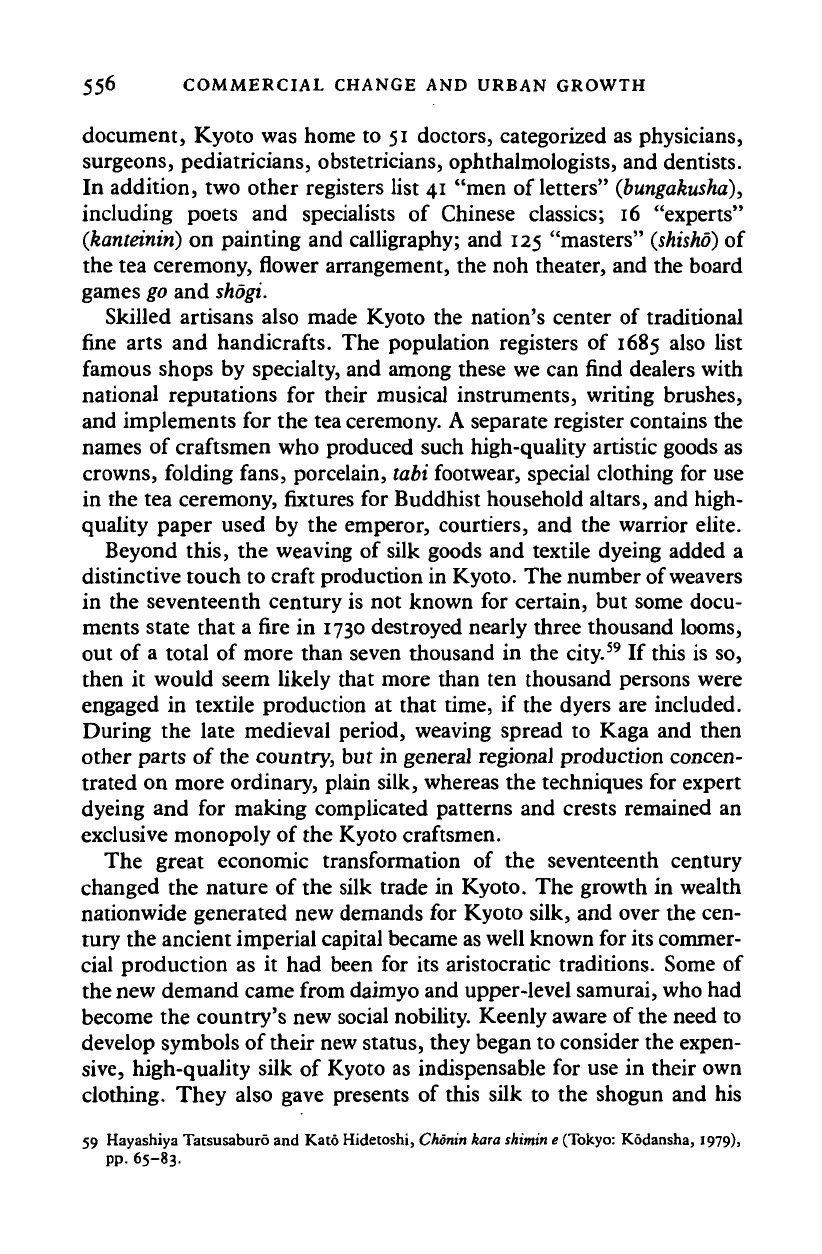
556 COMMERCIAL CHANGE AND URBAN GROWTH
document, Kyoto was home to 51 doctors, categorized as physicians,
surgeons, pediatricians, obstetricians, ophthalmologists, and dentists.
In addition, two other registers list 41 "men of letters"
(bungakusha),
including poets and specialists of Chinese classics; 16 "experts"
(kanteiniri)
on painting and calligraphy; and 125 "masters"
(shisho)
of
the tea ceremony, flower arrangement, the noh theater, and the board
games
go
and
shogi.
Skilled artisans also made Kyoto the nation's center of traditional
fine arts and handicrafts. The population registers of 1685 also list
famous shops by specialty, and among these we can find dealers with
national reputations for their musical instruments, writing brushes,
and implements for the tea ceremony. A separate register contains the
names of craftsmen who produced such high-quality artistic goods as
crowns, folding fans, porcelain, tabi footwear, special clothing for use
in the tea ceremony, fixtures for Buddhist household altars, and high-
quality paper used by the emperor, courtiers, and the warrior elite.
Beyond this, the weaving of silk goods and textile dyeing added a
distinctive touch to craft production in Kyoto. The number of weavers
in the seventeenth century is not known for certain, but some docu-
ments state that a fire in 1730 destroyed nearly three thousand looms,
out of a total of more than seven thousand in the city.
59
If this is so,
then it would seem likely that more than ten thousand persons were
engaged in textile production at that time, if the dyers are included.
During the late medieval period, weaving spread to Kaga and then
other parts of the country, but in general regional production concen-
trated on more ordinary, plain silk, whereas the techniques for expert
dyeing and for making complicated patterns and crests remained an
exclusive monopoly of the Kyoto craftsmen.
The great economic transformation of the seventeenth century
changed the nature of the silk trade in Kyoto. The growth in wealth
nationwide generated new demands for Kyoto silk, and over the cen-
tury the ancient imperial capital became as well known for its commer-
cial production as it had been for its aristocratic traditions. Some of
the new demand came from daimyo and upper-level samurai, who had
become the country's new social nobility. Keenly aware of the need to
develop symbols of their new status, they began to consider the expen-
sive,
high-quality silk of Kyoto as indispensable for use in their own
clothing. They also gave presents of this silk to the shogun and his
59 Hayashiya Tatsusaburo and Kato Hidetoshi,
Chdnin
kara
shitnin
e (Tokyo: Kodansha, 1979),
pp.
65-83.
Cambridge Histories Online © Cambridge University Press, 2008
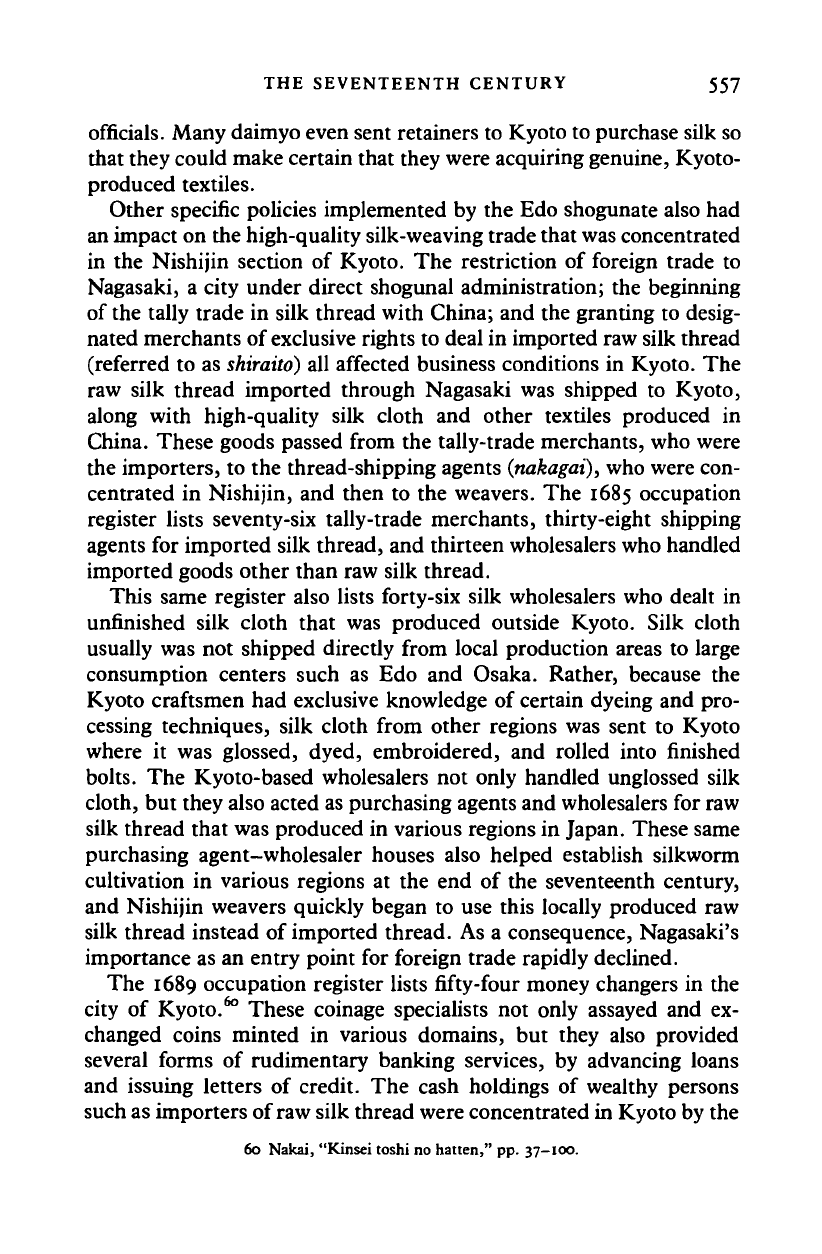
THE SEVENTEENTH CENTURY 557
officials. Many daimyo even sent retainers to Kyoto to purchase silk so
that they could make certain that they were acquiring genuine, Kyoto-
produced textiles.
Other specific policies implemented by the Edo shogunate also had
an impact on the high-quality silk-weaving trade that was concentrated
in the Nishijin section of Kyoto. The restriction of foreign trade to
Nagasaki, a city under direct shogunal administration; the beginning
of the tally trade in silk thread with China; and the granting to desig-
nated merchants of exclusive rights to deal in imported raw silk thread
(referred to as
shiraito)
all affected business conditions in Kyoto. The
raw silk thread imported through Nagasaki was shipped to Kyoto,
along with high-quality silk cloth and other textiles produced in
China. These goods passed from the tally-trade merchants, who were
the importers, to the thread-shipping agents
(nakagai),
who were con-
centrated in Nishijin, and then to the weavers. The 1685 occupation
register lists seventy-six tally-trade merchants, thirty-eight shipping
agents for imported silk thread, and thirteen wholesalers who handled
imported goods other than raw silk thread.
This same register also lists forty-six silk wholesalers who dealt in
unfinished silk cloth that was produced outside Kyoto. Silk cloth
usually was not shipped directly from local production areas to large
consumption centers such as Edo and Osaka. Rather, because the
Kyoto craftsmen had exclusive knowledge of certain dyeing and pro-
cessing techniques, silk cloth from other regions was sent to Kyoto
where it was glossed, dyed, embroidered, and rolled into finished
bolts.
The Kyoto-based wholesalers not only handled unglossed silk
cloth, but they also acted as purchasing agents and wholesalers for raw
silk thread that was produced in various regions in Japan. These same
purchasing agent-wholesaler houses also helped establish silkworm
cultivation in various regions at the end of the seventeenth century,
and Nishijin weavers quickly began to use this locally produced raw
silk thread instead of imported thread. As a consequence, Nagasaki's
importance as an entry point for foreign trade rapidly declined.
The 1689 occupation register lists fifty-four money changers in the
city of Kyoto.
60
These coinage specialists not only assayed and ex-
changed coins minted in various domains, but they also provided
several forms of rudimentary banking services, by advancing loans
and issuing letters of credit. The cash holdings of wealthy persons
such as importers of raw silk thread were concentrated in Kyoto by the
60 Nakai, "Kinsei toshi no hatten," pp. 37-100.
Cambridge Histories Online © Cambridge University Press, 2008
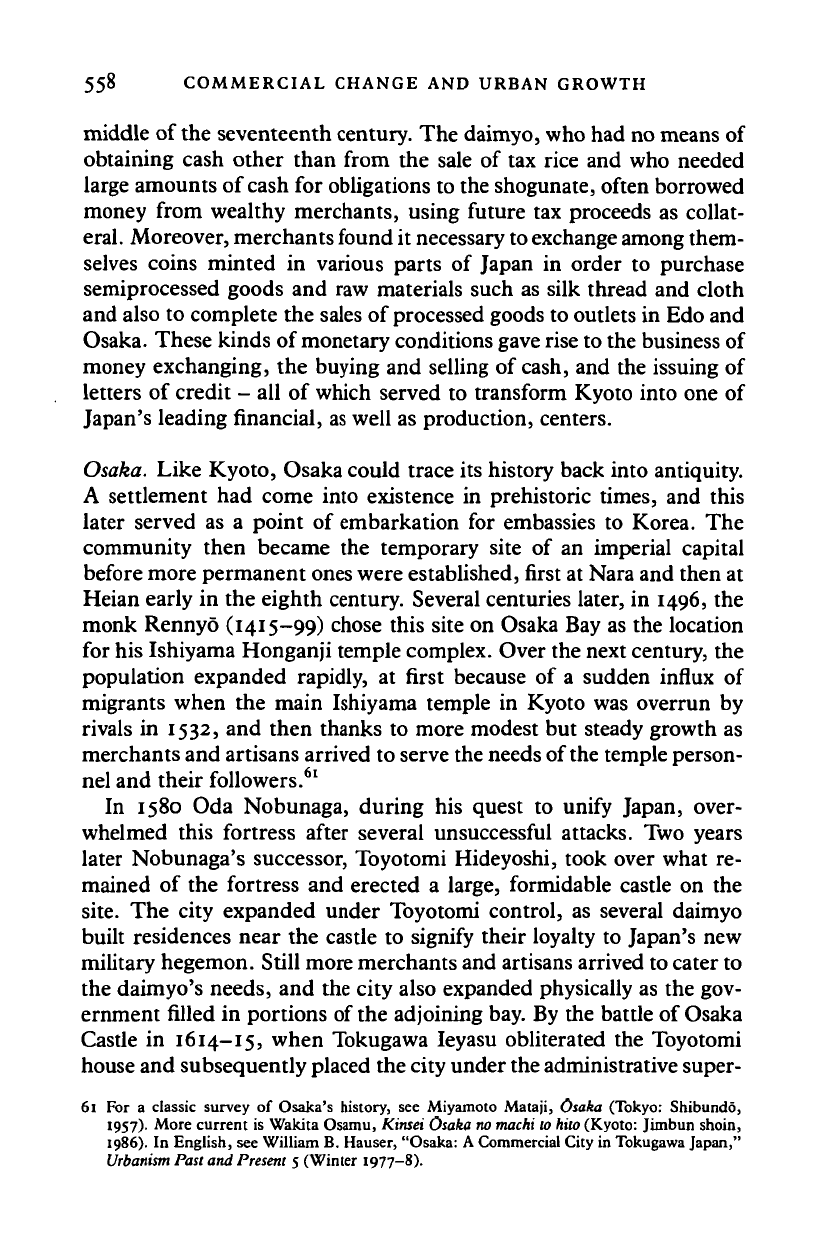
558 COMMERCIAL CHANGE AND URBAN GROWTH
middle of the seventeenth century. The daimyo, who had no means of
obtaining cash other than from the sale of tax rice and who needed
large amounts of cash for obligations to the shogunate, often borrowed
money from wealthy merchants, using future tax proceeds as collat-
eral. Moreover, merchants found it necessary to exchange among them-
selves coins minted in various parts of Japan in order to purchase
semiprocessed goods and raw materials such as silk thread and cloth
and also to complete the sales of processed goods to outlets in Edo and
Osaka. These kinds of monetary conditions gave rise to the business of
money exchanging, the buying and selling of cash, and the issuing of
letters of credit - all of which served to transform Kyoto into one of
Japan's leading financial, as well as production, centers.
Osaka. Like Kyoto, Osaka could trace its history back into antiquity.
A settlement had come into existence in prehistoric times, and this
later served as a point of embarkation for embassies to Korea. The
community then became the temporary site of an imperial capital
before more permanent ones were established, first at Nara and then at
Heian early in the eighth century. Several centuries later, in 1496, the
monk Rennyo (1415-99) chose this site on Osaka Bay as the location
for his Ishiyama Honganji temple complex. Over the next century, the
population expanded rapidly, at first because of a sudden influx of
migrants when the main Ishiyama temple in Kyoto was overrun by
rivals in 1532, and then thanks to more modest but steady growth as
merchants and artisans arrived to serve the needs of
the
temple person-
nel and their followers.
61
In 1580 Oda Nobunaga, during his quest to unify Japan, over-
whelmed this fortress after several unsuccessful attacks. Two years
later Nobunaga's successor, Toyotomi Hideyoshi, took over what re-
mained of the fortress and erected a large, formidable castle on the
site.
The city expanded under Toyotomi control, as several daimyo
built residences near the castle to signify their loyalty to Japan's new
military hegemon. Still more merchants and artisans arrived to cater to
the daimyo's needs, and the city also expanded physically as the gov-
ernment filled in portions of the adjoining bay. By the battle of Osaka
Castle in 1614-15, when Tokugawa Ieyasu obliterated the Toyotomi
house and subsequently placed the city under the administrative super-
61 For a classic survey of Osaka's history, see Miyamoto Mataji, Osaka (Tokyo: Shibundo,
1957).
More current is Wakita Osamu, Kinsei Osaka no machi to hito (Kyoto: Jimbun shoin,
1986).
In English, see William B. Hauser, "Osaka: A Commercial City in Tokugawa Japan,"
Urbanism
Past and Present 5 (Winter 1977-8).
Cambridge Histories Online © Cambridge University Press, 2008
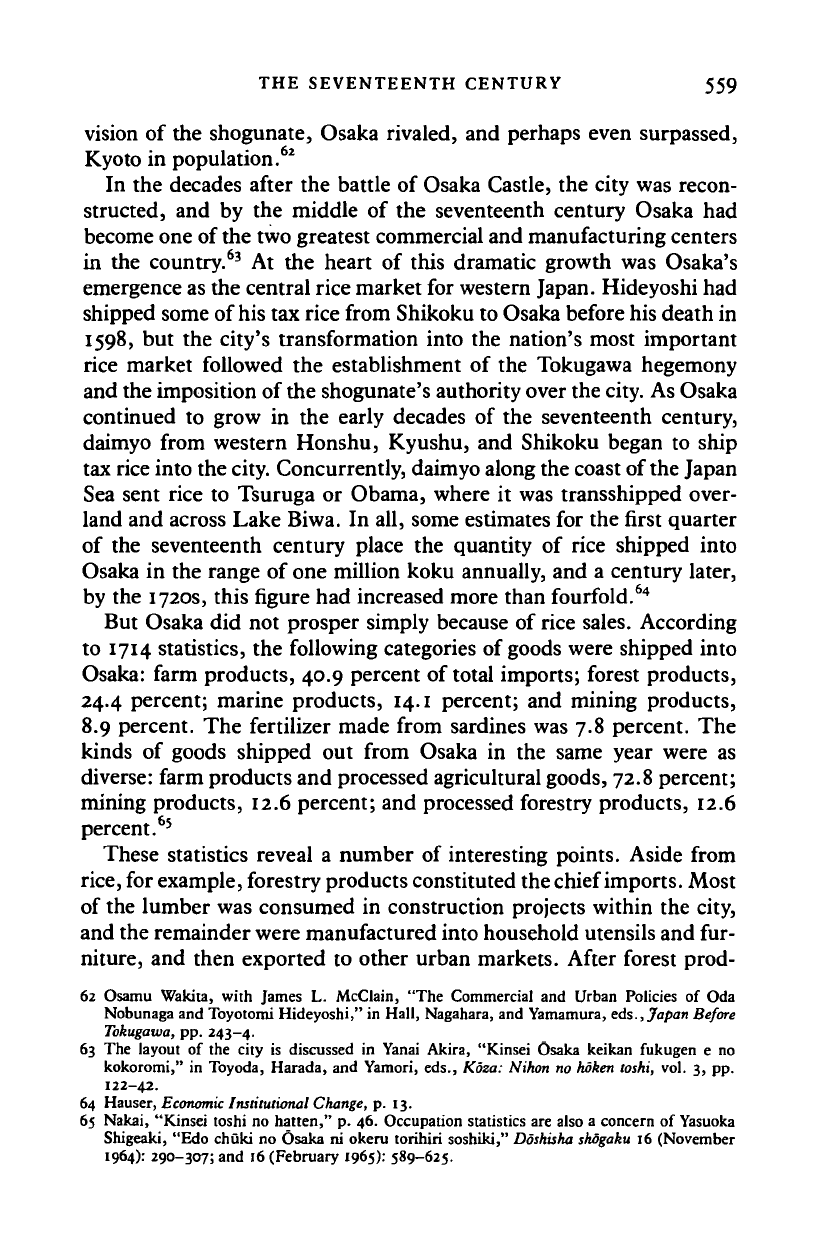
THE SEVENTEENTH CENTURY 559
vision of the shogunate, Osaka rivaled, and perhaps even surpassed,
Kyoto in population.
62
In the decades after the battle of Osaka Castle, the city was recon-
structed, and by the middle of the seventeenth century Osaka had
become one of the two greatest commercial and manufacturing centers
in the country.
63
At the heart of this dramatic growth was Osaka's
emergence as the central rice market for western Japan. Hideyoshi had
shipped some of his tax rice from Shikoku to Osaka before his death in
1598,
but the city's transformation into the nation's most important
rice market followed the establishment of the Tokugawa hegemony
and the imposition of the shogunate's authority over the
city.
As Osaka
continued to grow in the early decades of the seventeenth century,
daimyo from western Honshu, Kyushu, and Shikoku began to ship
tax rice into the
city.
Concurrently, daimyo along the coast of the Japan
Sea sent rice to Tsuruga or Obama, where it was transshipped over-
land and across Lake Biwa. In all, some estimates for the first quarter
of the seventeenth century place the quantity of rice shipped into
Osaka in the range of one million koku annually, and a century later,
by the 1720s, this figure had increased more than fourfold.
64
But Osaka did not prosper simply because of rice sales. According
to 1714 statistics, the following categories of goods were shipped into
Osaka: farm products, 40.9 percent of total imports; forest products,
24.4 percent; marine products, 14.1 percent; and mining products,
8.9 percent. The fertilizer made from sardines was 7.8 percent. The
kinds of goods shipped out from Osaka in the same year were as
diverse: farm products and processed agricultural goods, 72.8 percent;
mining products, 12.6 percent; and processed forestry products, 12.6
percent.
65
These statistics reveal a number of interesting points. Aside from
rice,
for
example,
forestry products constituted the chief imports. Most
of the lumber was consumed in construction projects within the city,
and the remainder were manufactured into household utensils and fur-
niture, and then exported to other urban markets. After forest prod-
62 Osamu Wakita, with James L. McClain, "The Commercial and Urban Policies of Oda
Nobunaga and Toyotomi Hideyoshi," in Hall, Nagahara, and Yamamura, eds., Japan Before
Tokugawa, pp. 243-4.
63 The layout of the city is discussed in Yanai Akira, "Kinsei Osaka keikan fukugen e no
kokoromi," in Toyoda, Harada, and Yamori, eds., Koza: Nihon no
hoken
toshi, vol. 3, pp.
122-42.
64 Hauser,
Economic
Institutional Change, p. 13.
65 Nakai, "Kinsei toshi no hatten," p. 46. Occupation statistics are also a concern of Yasuoka
Shigeaki, "Edo chuki no Osaka ni okeru torihiri soshiki," Doshisha
shdgaku
16 (November
1964):
290-307; and 16 (February 1965): 589-625.
Cambridge Histories Online © Cambridge University Press, 2008
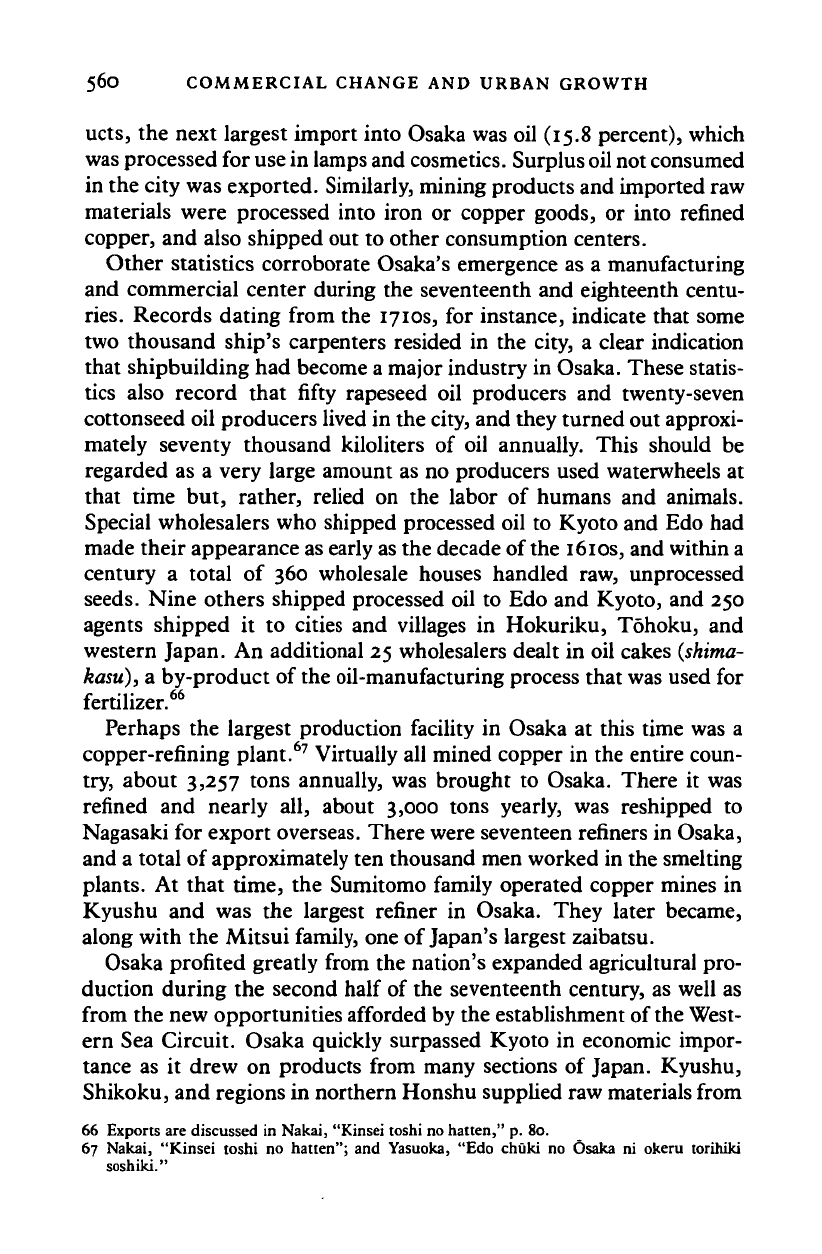
560 COMMERCIAL CHANGE AND URBAN GROWTH
ucts,
the
next largest import into Osaka was
oil
(15.8 percent), which
was processed for use in lamps and
cosmetics.
Surplus
oil
not consumed
in the city was exported. Similarly, mining products and imported raw
materials were processed into iron
or
copper goods,
or
into refined
copper, and also shipped out
to
other consumption centers.
Other statistics corroborate Osaka's emergence
as a
manufacturing
and commercial center during
the
seventeenth
and
eighteenth centu-
ries.
Records dating from
the
1710s,
for
instance, indicate that some
two thousand ship's carpenters resided
in the
city,
a
clear indication
that shipbuilding had become a major industry in Osaka. These statis-
tics also record that fifty rapeseed
oil
producers
and
twenty-seven
cottonseed oil producers lived in the city, and they turned out approxi-
mately seventy thousand kiloliters
of oil
annually. This should
be
regarded
as a
very large amount
as no
producers used waterwheels
at
that time
but,
rather, relied
on the
labor
of
humans
and
animals.
Special wholesalers who shipped processed oil
to
Kyoto and Edo had
made their appearance as early as the decade of the 1610s, and within
a
century
a
total
of 360
wholesale houses handled
raw,
unprocessed
seeds.
Nine others shipped processed
oil to
Edo
and
Kyoto,
and
250
agents shipped
it to
cities
and
villages
in
Hokuriku, Tohoku,
and
western Japan.
An
additional 25 wholesalers dealt
in
oil cakes
(shima-
kasu),
a
by-product
of
the oil-manufacturing process that was used
for
fertilizer.
66
Perhaps
the
largest production facility
in
Osaka
at
this time was
a
copper-refining plant.
67
Virtually all mined copper
in
the entire coun-
try, about 3,257 tons annually,
was
brought
to
Osaka. There
it was
refined
and
nearly
all,
about 3,000 tons yearly,
was
reshipped
to
Nagasaki
for
export overseas. There were seventeen refiners in Osaka,
and
a
total
of
approximately ten thousand men worked in the smelting
plants.
At
that time,
the
Sumitomo family operated copper mines
in
Kyushu
and was the
largest refiner
in
Osaka. They later became,
along with
the
Mitsui family, one
of
Japan's largest zaibatsu.
Osaka profited greatly from the nation's expanded agricultural pro-
duction during
the
second half
of
the seventeenth century,
as
well
as
from the new opportunities afforded by the establishment of
the
West-
ern
Sea
Circuit. Osaka quickly surpassed Kyoto
in
economic impor-
tance
as it
drew
on
products from many sections
of
Japan. Kyushu,
Shikoku, and regions in northern Honshu supplied raw materials from
66 Exports are discussed
in
Nakai, "Kinsei toshi no hatten," p.
80.
67 Nakai, "Kinsei toshi
no
hatten";
and
Yasuoka,
"Edo
chuki
no
Osaka
ni
okeru torihiki
soshiki."
Cambridge Histories Online © Cambridge University Press, 2008
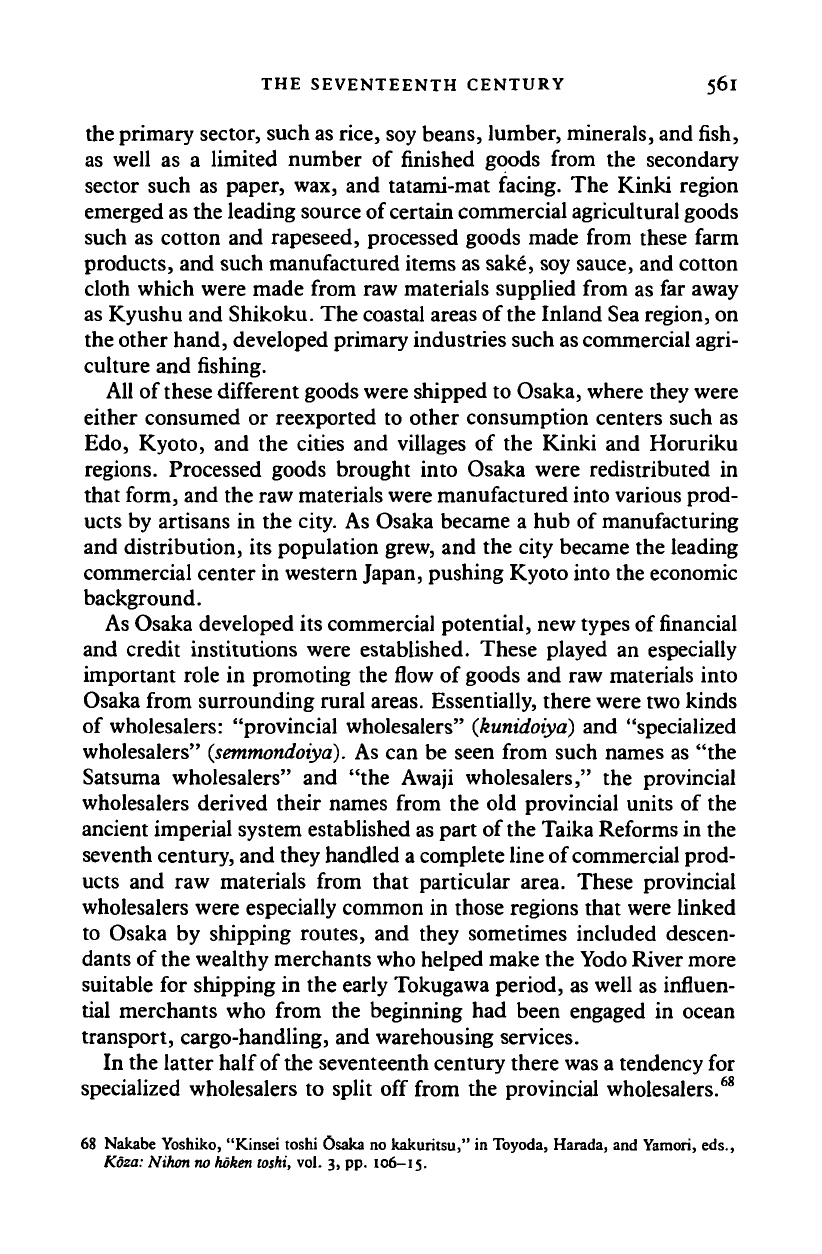
THE SEVENTEENTH CENTURY 561
the primary sector, such as rice, soy beans, lumber, minerals, and fish,
as well as a limited number of finished goods from the secondary
sector such as paper, wax, and tatami-mat facing. The Kinki region
emerged as the leading source of certain commercial agricultural goods
such as cotton and rapeseed, processed goods made from these farm
products, and such manufactured items as sake, soy sauce, and cotton
cloth which were made from raw materials supplied from as far away
as Kyushu and Shikoku. The coastal areas of
the
Inland Sea region, on
the other hand, developed primary industries such as commercial agri-
culture and fishing.
All of these different goods were shipped to Osaka, where they were
either consumed or reexported to other consumption centers such as
Edo,
Kyoto, and the cities and villages of the Kinki and Horuriku
regions. Processed goods brought into Osaka were redistributed in
that form, and the raw materials were manufactured into various prod-
ucts by artisans in the city. As Osaka became a hub of manufacturing
and distribution, its population grew, and the city became the leading
commercial center in western Japan, pushing Kyoto into the economic
background.
As Osaka developed its commercial potential, new types of financial
and credit institutions were established. These played an especially
important role in promoting the flow of goods and raw materials into
Osaka from surrounding rural areas. Essentially, there were two kinds
of wholesalers: "provincial wholesalers"
(kunidoiya)
and "specialized
wholesalers"
(semmondoiya).
As can be seen from such names as "the
Satsuma wholesalers" and "the Awaji wholesalers," the provincial
wholesalers derived their names from the old provincial units of the
ancient imperial system established as part of
the
Taika Reforms in the
seventh century, and they handled a complete line of commercial prod-
ucts and raw materials from that particular area. These provincial
wholesalers were especially common in those regions that were linked
to Osaka by shipping routes, and they sometimes included descen-
dants of the wealthy merchants who helped make the Yodo River more
suitable for shipping in the early Tokugawa period, as well as influen-
tial merchants who from the beginning had been engaged in ocean
transport, cargo-handling, and warehousing services.
In the latter half of
the
seventeenth century there was a tendency for
specialized wholesalers to split off from the provincial wholesalers.
68
68 Nakabe Yoshiko, "Kinsei toshi Osaka no kakuritsu," in Toyoda, Harada, and Yamori, eds.,
Koza: Nihon no
hoken
toshi, vol. 3, pp. 106-15.
Cambridge Histories Online © Cambridge University Press, 2008
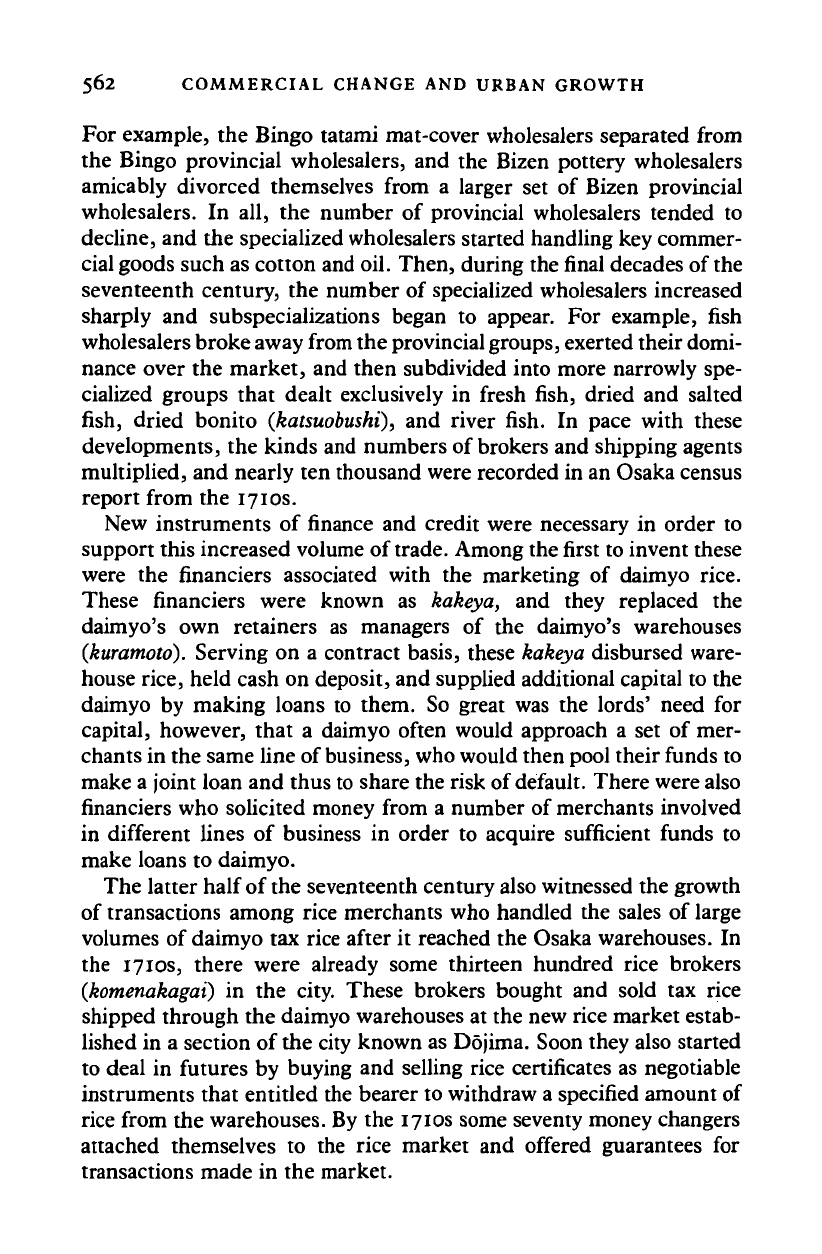
562 COMMERCIAL CHANGE AND URBAN GROWTH
For example, the Bingo tatami mat-cover wholesalers separated from
the Bingo provincial wholesalers, and the Bizen pottery wholesalers
amicably divorced themselves from a larger set of Bizen provincial
wholesalers. In all, the number of provincial wholesalers tended to
decline, and the specialized wholesalers started handling key commer-
cial goods such as cotton and oil. Then, during the
final
decades of the
seventeenth century, the number of specialized wholesalers increased
sharply and subspecializations began to appear. For example, fish
wholesalers broke away from the provincial
groups,
exerted their domi-
nance over the market, and then subdivided into more narrowly spe-
cialized groups that dealt exclusively in fresh fish, dried and salted
fish, dried bonito
(katsuobushi),
and river fish. In pace with these
developments, the kinds and numbers of brokers and shipping agents
multiplied, and nearly ten thousand were recorded in an Osaka census
report from the 1710s.
New instruments of finance and credit were necessary in order to
support this increased volume of trade. Among the first to invent these
were the financiers associated with the marketing of daimyo rice.
These financiers were known as kakeya, and they replaced the
daimyo's own retainers as managers of the daimyo's warehouses
(kuramoto).
Serving on a contract basis, these
kakeya
disbursed ware-
house rice, held cash on deposit, and supplied additional capital to the
daimyo by making loans to them. So great was the lords' need for
capital, however, that a daimyo often would approach a set of mer-
chants in the same line of
business,
who would then pool their funds to
make a joint loan and thus to share the risk of default. There were also
financiers who solicited money from a number of merchants involved
in different lines of business in order to acquire sufficient funds to
make loans to daimyo.
The latter half of the seventeenth century also witnessed the growth
of transactions among rice merchants who handled the sales of large
volumes of daimyo tax rice after it reached the Osaka warehouses. In
the 1710s, there were already some thirteen hundred rice brokers
(komenakagai)
in the city. These brokers bought and sold tax rice
shipped through the daimyo warehouses at the new rice market estab-
lished in a section of the city known as Dojima. Soon they also started
to deal in futures by buying and selling rice certificates as negotiable
instruments that entitled the bearer to withdraw a specified amount of
rice from the warehouses. By the 1710s some seventy money changers
attached themselves to the rice market and offered guarantees for
transactions made in the market.
Cambridge Histories Online © Cambridge University Press, 2008
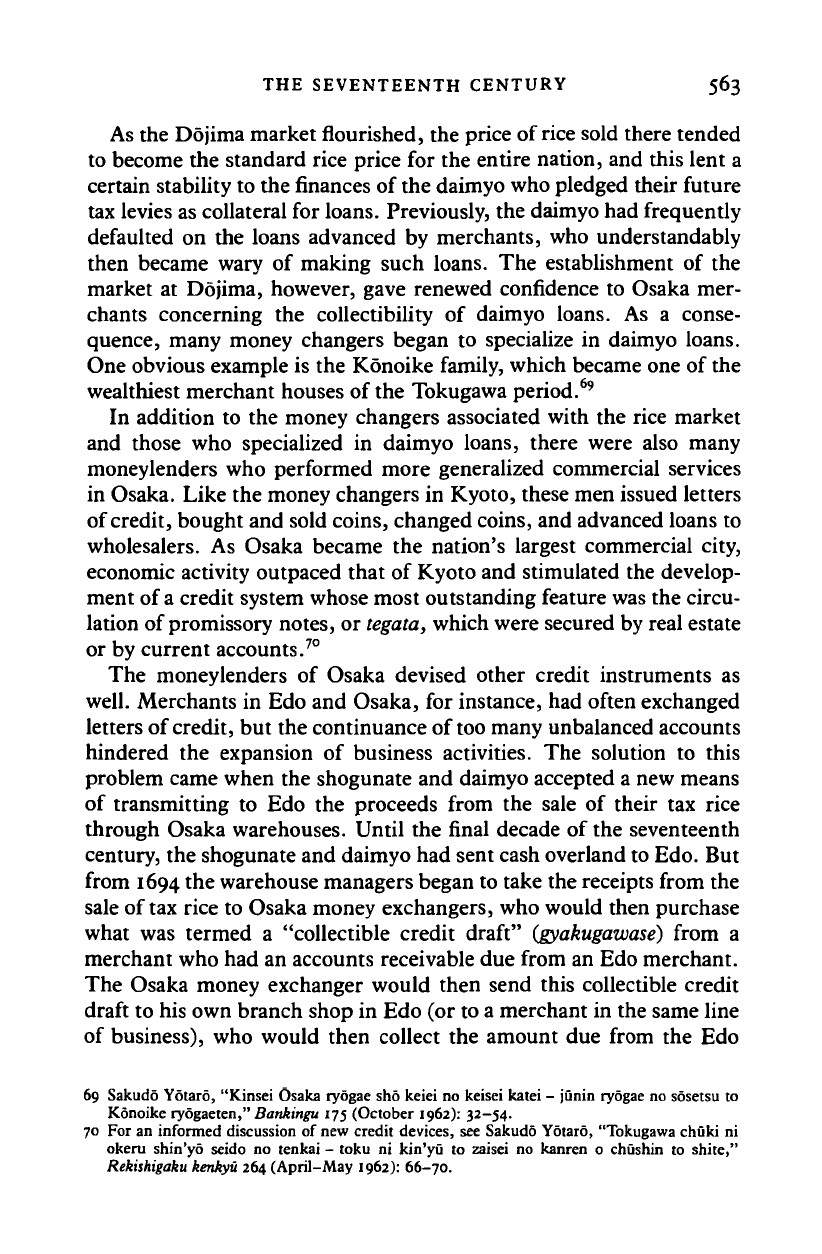
THE SEVENTEENTH CENTURY 563
As the Dojima market flourished, the price of
rice
sold there tended
to become the standard rice price for the entire nation, and this lent a
certain stability to the
finances
of the daimyo who pledged their future
tax levies as collateral for
loans.
Previously, the daimyo had frequently
defaulted on the loans advanced by merchants, who understandably
then became wary of making such loans. The establishment of the
market at Dojima, however, gave renewed confidence to Osaka mer-
chants concerning the collectibility of daimyo loans. As a conse-
quence, many money changers began to specialize in daimyo loans.
One obvious example is the Konoike family, which became one of the
wealthiest merchant houses of the Tokugawa period.
69
In addition to the money changers associated with the rice market
and those who specialized in daimyo loans, there were also many
moneylenders who performed more generalized commercial services
in Osaka. Like the money changers in Kyoto, these men issued letters
of credit, bought and sold coins, changed coins, and advanced loans to
wholesalers. As Osaka became the nation's largest commercial city,
economic activity outpaced that of Kyoto and stimulated the develop-
ment of a credit system whose most outstanding feature was the circu-
lation of promissory notes, or
tegata,
which were secured by real estate
or by current accounts.
70
The moneylenders of Osaka devised other credit instruments as
well. Merchants in Edo and Osaka, for instance, had often exchanged
letters of credit, but the continuance of
too
many unbalanced accounts
hindered the expansion of business activities. The solution to this
problem came when the shogunate and daimyo accepted a new means
of transmitting to Edo the proceeds from the sale of their tax rice
through Osaka warehouses. Until the final decade of the seventeenth
century, the shogunate and daimyo had sent cash overland to Edo. But
from 1694 the warehouse managers began to take the receipts from the
sale of tax rice to Osaka money exchangers, who would then purchase
what was termed a "collectible credit draft"
(gyakugawase)
from a
merchant who had an accounts receivable due from an Edo merchant.
The Osaka money exchanger would then send this collectible credit
draft to his own branch shop in Edo (or to a merchant in the same line
of business), who would then collect the amount due from the Edo
69 Sakudo Yotaro, "Kinsei Osaka ryogae sho keiei no keisei katei - junin ryogae no sosetsu to
Konoike ryogaeten," Bankingu 175 (October 1962): 32-54.
70 For an informed discussion of new credit devices, see Sakudo Yotaro, "Tokugawa chuki ni
okeru shin'yo seido no tenkai - toku ni kin'yu to zaisei no kanren o chushin to shite,"
Rekishigaku kenkyii 264 (April-May 1962): 66-70.
Cambridge Histories Online © Cambridge University Press, 2008
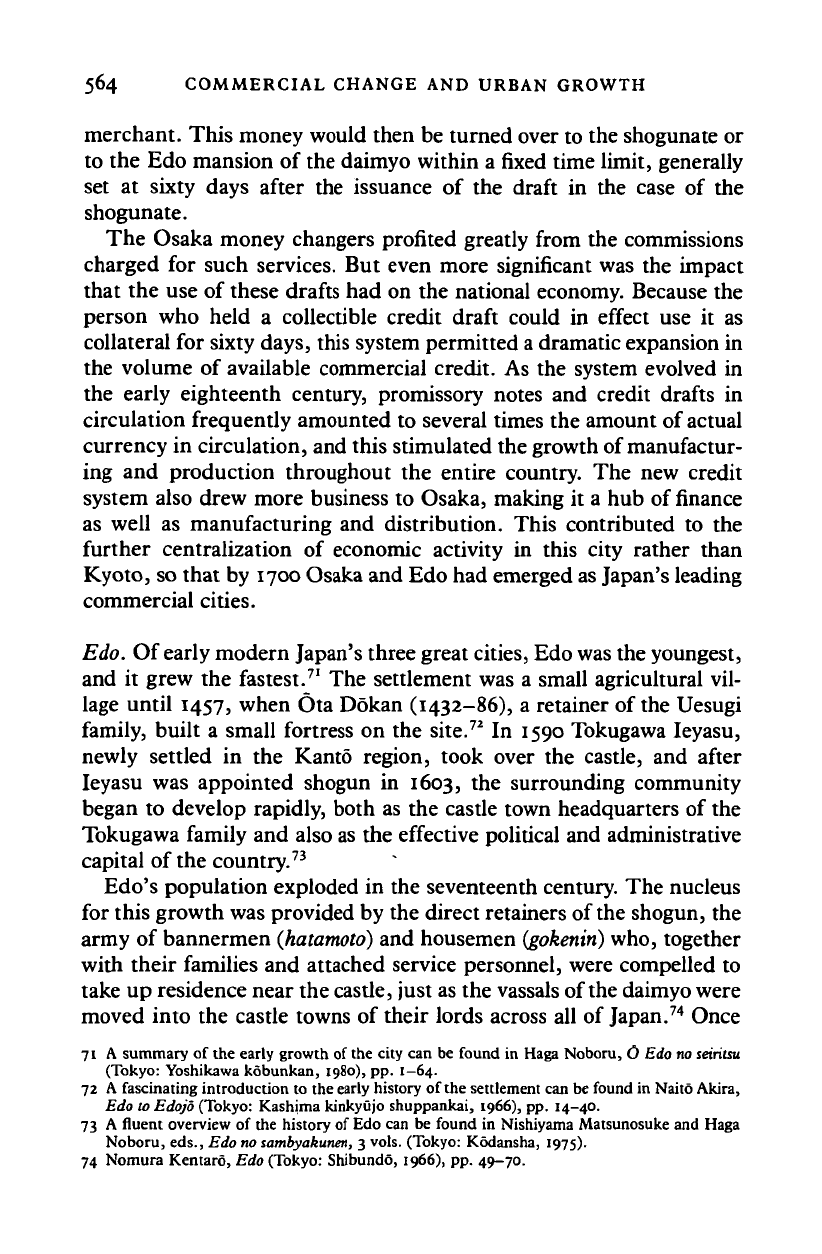
564 COMMERCIAL CHANGE AND URBAN GROWTH
merchant. This money would then be turned over to the shogunate or
to the Edo mansion of the daimyo within a fixed time limit, generally
set at sixty days after the issuance of the draft in the case of the
shogunate.
The Osaka money changers profited greatly from the commissions
charged for such services. But even more significant was the impact
that the use of these drafts had on the national economy. Because the
person who held a collectible credit draft could in effect use it as
collateral for sixty days, this system permitted
a
dramatic expansion in
the volume of available commercial credit. As the system evolved in
the early eighteenth century, promissory notes and credit drafts in
circulation frequently amounted to several times the amount of actual
currency in circulation, and this stimulated the growth of manufactur-
ing and production throughout the entire country. The new credit
system also drew more business to Osaka, making it a hub of finance
as well as manufacturing and distribution. This contributed to the
further centralization of economic activity in this city rather than
Kyoto, so that by 1700 Osaka and Edo had emerged as Japan's leading
commercial cities.
Edo.
Of early modern Japan's three great cities, Edo was the youngest,
and it grew the fastest.
71
The settlement was a small agricultural vil-
lage until 1457, when Ota Dokan (1432-86), a retainer of the Uesugi
family, built a small fortress on the site.
72
In 1590 Tokugawa Ieyasu,
newly settled in the Kanto region, took over the castle, and after
Ieyasu was appointed shogun in 1603, the surrounding community
began to develop rapidly, both as the castle town headquarters of the
Tokugawa family and also as the effective political and administrative
capital of the country.
73
Edo's population exploded in the seventeenth century. The nucleus
for this growth was provided by the direct retainers of the shogun, the
army of bannermen
Qiatamoto)
and housemen
igokenin)
who, together
with their families and attached service personnel, were compelled to
take up residence near the castle, just as the vassals of the daimyo were
moved into the castle towns of their lords across all of Japan.
74
Once
71 A summary of the early growth of the city can be found in Haga Noboru, 0 Edo no
seiritsu
(Tokyo: Yoshikawa kobunkan, 1980), pp. 1-64.
72 A fascinating introduction to the early history of the settlement can be found in Naito Akira,
Edo to Edojo (Tokyo: Kashima kinkyujo shuppankai, 1966), pp. 14-40.
73 A fluent overview of the history of Edo can be found in Nishiyama Matsunosuke and Haga
Noboru, eds., Edo no
sambyakunen,
3 vols. (Tokyo: Kodansha, 1975).
74 Nomura Kentaro, Edo (Tokyo: Shibundo, 1966), pp. 49-70.
Cambridge Histories Online © Cambridge University Press, 2008
